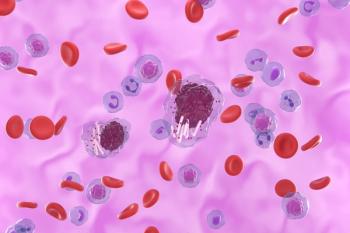
COVID-19 Deaths Cloud Interpretation of Acalabrutinib-Venetoclax Combo Results
Key Takeaways
- AVO combination showed higher undetectable MRD rates than acalabrutinib and venetoclax or chemoimmunotherapy, with sustained benefits up to 36 months post-therapy.
- Cross-trial comparisons indicated a potential progression-free survival advantage for ibrutinib plus venetoclax, though significance was affected by COVID-19-related deaths.
A combination of acalabrutinib and venetoclax showed better results with the addition of obinutuzumab, whereas mixed findings in a cross-trial comparison were complicated by the inclusion of deaths related to COVID-19.
A fixed-duration combination of acalabrutinib and venetoclax plus obinutuzimab (AVO) yielded better rates of undetectable disease than acalabrutinib and venetoclax alone or chemoimmunotherapy in patients with treatment-naïve chronic lymphocytic leukemia (CLL), new results show. Although cross-trial comparisons indicate an advantage with ibrutinib plus venetoclax over acalabrutinib and venetoclax, some findings lose significance when excluding COVID-19–related deaths, which were examined in detail in a separate presentation.
All 3 posters, which analyzed data from the AMPLIFY trial now ongoing in phase 3 (NCT03836261), were presented at the
MRD Advantage of AVO vs Chemoimmunotherapy
In one poster presented at EHA, researchers delved further into measurable residual disease (MRD) kinetics with these combinations vs chemoimmunotherapy in the same trial.2 Among the 867 patients randomly assigned to receive acalabrutinib and venetoclax, AVO, or investigator’s choice of fludarabine-cyclophosphamide-rituximab/bendamustine-rituximab (FCR/BR), researchers assessed MRD via flow cytometry and next-generation sequencing.
Results indicate that undetectable MRD rates were significantly higher in the AVO arm at the end of therapy than in the acalabrutinib and venetoclax and FCR/BR arms: 95% vs 45% and 73%, respectively. These differences persisted to 12 weeks after the end of therapy, at 94% for AVO vs 38% for acalabrutinib and venetoclax and 78% for FCR/BR. Even as far out as 36 months after the end of therapy, the AVO arm had the highest rate of undetectable MRD rates in peripheral blood by flow cytometry, at 72% vs 37% for acalabrutinib and venetoclax and 45% for FCR/BR. Those who achieved undetectable MRD by the end of therapy had a numerically lower risk of disease progression or death if they received acalabrutinib and venetoclax or AVO vs FCR/BR, with the difference more significant in those with unmutated IGHV.
“AVO achieved the highest [undetectable] MRD rates regardless of methodology or IGHV status,” the authors concluded. Their poster added the context that these results can help inform treatment decisions for patients with previously untreated CLL, especially in those who prefer a shorter duration of treatment. Although European regulatory bodies have not yet adopted MRD as a surrogate end point for approvals, clinicians are largely on board with
Cross-Trial Comparison Yields Mixed Findings
Another poster used data from AMPLIFY as well as the phase 2 CAPTIVATE trial (NCT02910583), which evaluated fixed-duration ibrutinib plus venetoclax in a similar patient population, to compare the regimens’ efficacy.4 Initial analysis showed a significant progression-free survival (PFS) benefit with ibrutinib plus venetoclax over acalabrutinib and venetoclax, at 1.69 months (95% CI, 0.14-3.24; P = .029) over 3 years. However, the difference was no longer significant when COVID-19–related deaths were excluded. PFS differences between regimens were also insignificant among patients with mutated IGHV only.
“While these findings are limited by the indirect nature of the comparison, they suggest that [fixed-duration ibrutinib plus venetoclax] may offer a PFS advantage over [acalabrutinib and venetoclax] in treatment-naïve, fit CLL patients without TP53 aberrations,” the authors wrote.
COVID-19 Events in AMPLIFY
Lending more context to the impact of COVID-19 on the AMPLIFY trial, another EHA poster looked specifically at COVID-19 vaccinations, infections, and deaths across the trial, which spanned from 2019 to 2021 and as such was impacted by both the original SARS-CoV-2 virus and subsequent waves of alpha, beta, gamma, delta, and omicron variants.5
COVID-19–related events were fairly common, seen in 37.5%, 45.8%, and 27.9% of patients in the acalabrutinib and venetoclax, AVO, and FCR/BR arms, respectively. The prevalence of COVID-19 adverse events of grade 3 or higher was highest in the AVO arm at 22.9%, vs 10.0% for acalabrutinib and venetoclax and 14.7% for FCR/BR; deaths due to COVID-19 followed a similar pattern, at 8.7% in the AVO arm vs 3.4% for acalabrutinib and venetoclax and 7.2% for FCR/BR.
“COVID-19 deaths were most prevalent during the second pandemic wave, particularly in the AVO and FCR/BR arms,” the authors noted. They also observed that nearly 7 in 10 (69.6%) of the COVID-19 deaths occurred in Eastern Europe and that vaccination rates were lower among patients who died of COVID-19.
References
1. Caffrey M. Fixed-duration acalabrutinib plus venetoclax beats chemoimmunotherapy in first-line CLL; adding obinutuzumab boosts PFS. AJMC®. December 10, 2024. Accessed June 9, 2025.
2. Ghia P, Skarbnik A, Jurczak W, et al. Measurable residual disease kinetics with fixed-duration acalabrutinib-venetoclax combinations in treatment-naïve chronic lymphocytic leukemia: data from the phase 3 AMPLIFY trial. Poster presented at: EHA 2025; June 12-15, 2025; Milan, Italy. Poster PF572.
3. Mattina C. Measurable residual disease in decision-making: an opportunity, but not a promise. AJMC. June 13, 2025. Accessed June 13, 2025.
4. Molica S, Allsup D, Giannarelli D. Fixed-duration BTKI-venetoclax combinations in CLL: an indirect comparison of AMPLIFY and CAPTIVATE trials. Poster presented at: EHA 2025; June 12-15, 2025; Milan, Italy. Poster PS1580.
5. Brown JR, Kater AP, Jurczak W, et al. Analysis of COVID-19 infections with fixed-duration acalabrutinib-venetoclax combinations in treatment-naïve chronic lymphocytic leukemia in the phase 3 AMPLIFY trial. Poster presented at: EHA 2025; June 12-15, 2025; Milan, Italy. Poster PS1574.
Newsletter
Stay ahead of policy, cost, and value—subscribe to AJMC for expert insights at the intersection of clinical care and health economics.









































